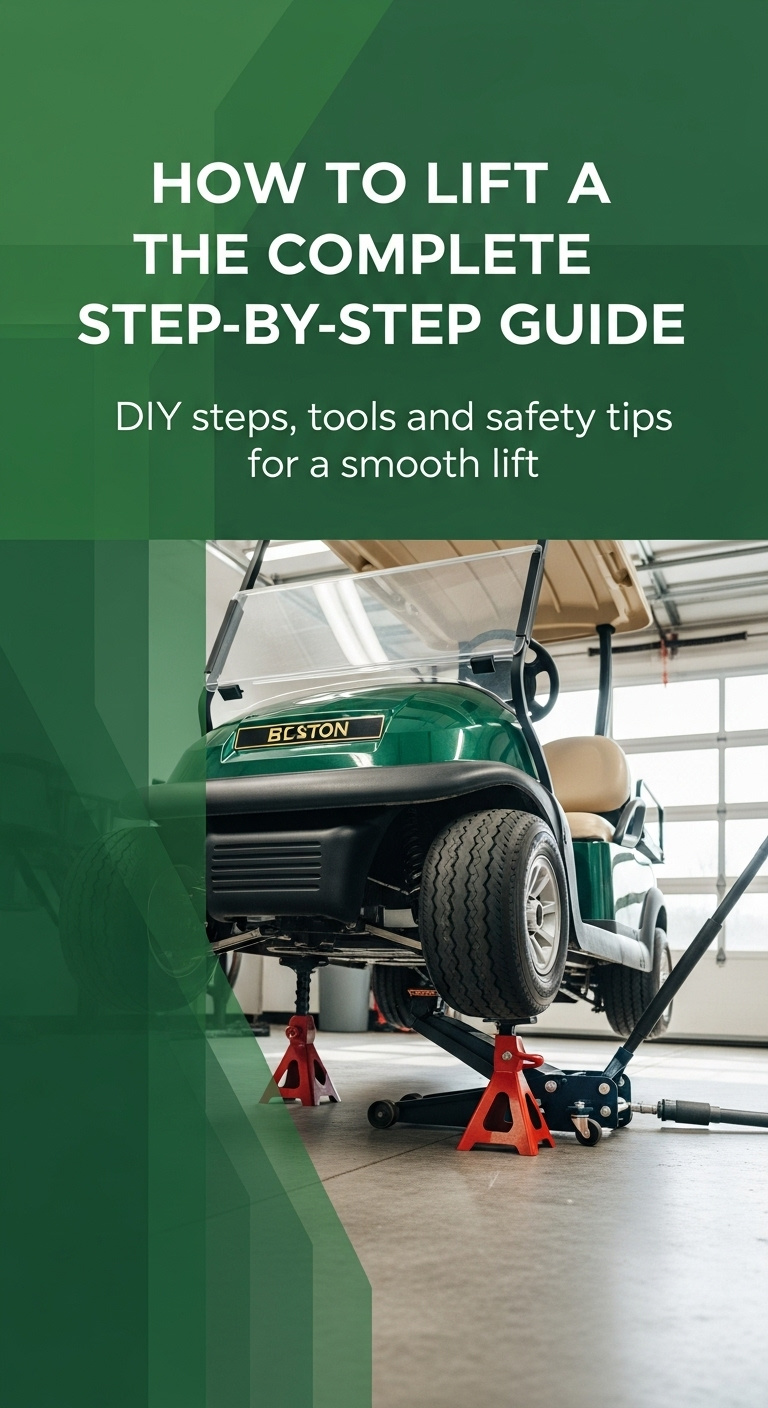As an Amazon Associate GolferHive.com earns from qualifying purchases.
How to Lift a Golf Cart: The Complete Step-by-Step Guide
Ready to transform your standard golf cart into a more capable and visually striking machine? You’re looking to tackle tougher terrain, fit larger, more aggressive tires, or simply give your cart a custom look that stands out. This guide provides the complete, data-driven blueprint for how to lift a golf cart, eliminating guesswork and ensuring a safe, successful project.
To lift a golf cart, you must install a dedicated lift kit designed for your specific model. The process involves safely jacking up the cart, removing the wheels, replacing stock suspension components like spindles or A-arms with the new kit parts, and performing a final wheel alignment.
Leveraging extensive analysis of established installation patterns and manufacturer guidelines, this guide unpacks the proven step-by-step process. We’ll cover everything from choosing the right kit for your desired tire size to the critical safety checks and detailed installation instructions that ensure you get it right the first time.
Key Facts
- Lift Height Dictates Tire Size: The size of the lift kit directly determines the maximum tire size your cart can accommodate. Data shows a 6-inch lift is preferred for 23-inch tires, while a 3-4 inch lift is sufficient for 22-inch tires.
- Multiple Kit Types Exist: The most common types of golf cart lift kits are Spindle, A-Arm, and Drop Axle, each offering a different installation method and level of suspension modification.
- Safety is Paramount: Proper jack placement is a critical safety step. According to installation guides, the jack should be placed at the center of the front axle to ensure even force and prevent instability.
- A-Arm Kits Are a Heavy-Duty Option: Analysis of SERP data indicates that A-arm lift kits are a popular and heavy-duty choice, known for providing a rigid and significantly lifted appearance.
- Wheel Alignment is Non-Negotiable: A wheel alignment is a mandatory final step after installing a lift kit to ensure proper handling, steering, and to prevent uneven tire wear.
Why Lift a Golf Cart? Understanding the Core Benefits
Before you grab your tools, it’s essential to understand the core reasons why people choose to lift their carts. This modification is about more than just looks; it provides tangible performance enhancements that can completely change your driving experience. Which of these benefits is driving your decision to lift your cart?

🏔 Enhanced Off-Road Capability
The primary benefit is increased ground clearance. A lift kit raises the cart’s frame, allowing you to navigate rougher terrain, trails, and uneven surfaces without getting stuck or damaging the undercarriage.
📏 Accommodation for Larger Tires
Stock golf carts have limited wheel well space. Lifting your cart is necessary to fit larger, more aggressive all-terrain or off-road tires, which provide better traction and a smoother ride on bumpy ground.
🛋 Improved Ride Comfort
Many high-quality lift kits, especially A-Arm styles, replace stock suspension components with more robust parts. This can lead to improved suspension travel and a more comfortable, less jarring ride.
👸 Customized Aesthetic
A lifted golf cart has an imposing, customized look that stands out from standard models. It’s a significant visual upgrade that adds personality and value to your vehicle.

Choosing Your Lift: A Guide to Kit Types and Heights
Selecting the right lift kit is the most critical decision in this process. Your choice will depend on your desired tire size, your specific golf cart model (like Club Car, EZGO, or Yamaha), and your budget.
First, let’s look at the relationship between lift height and tire size. This is a non-negotiable formula: you must have enough lift to prevent your tires from rubbing against the wheel wells. Pro Tip: Measure your desired tire height before purchasing a lift kit to ensure a perfect fit.
| Required Lift Height | Tire Size (Inches) |
|---|---|
| No Lift Needed | 18″ – 20″ |
| 3-4″ Lift | 20.5″ – 22″ |
| 5-6″ Lift (6″ Preferred) | 23″ |
| 7-8″ Lift | 25″ |
Next, you need to understand the main types of golf cart lift kits. Each has a different installation method and design.
- Spindle Lift Kits: These are a very common choice. They work by replacing your cart’s factory spindles—the part the wheel hub attaches to—with longer ones. This effectively pushes the wheels further down, raising the front of the cart without altering the factory suspension geometry significantly.
- A-Arm Lift Kits: Considered one of the most robust and heavy-duty options, these kits replace the entire front suspension with new, beefier A-arms. They provide excellent stability and often improve ride quality, making them a popular choice for serious off-roading.
- Drop Axle Lift Kits: This type of kit replaces the entire front axle with a new one that has lowered spindle mounts. This raises the cart’s body while maintaining a comfortable ride. It’s a sturdy and reliable option.
- Block Lift Kits: The simplest and often most affordable option, block lifts use steel or aluminum blocks to create space between the frame and the rear leaf springs. This lifts the cart’s body but doesn’t change suspension components.
- Independent Rear Suspension (IRS) Kits: For modern carts with advanced IRS systems, these specialized kits provide a lift while maintaining the superior ride quality of the independent suspension.

Step 1: Preparation and Safety First
Before a single bolt is turned, ensuring your workspace and cart are prepared is crucial for a safe and efficient installation. Do not skip these steps.
- Find a Level Surface: Park your golf cart on a flat, level, and solid surface like a concrete garage floor. Never attempt to lift a vehicle on soft ground, grass, or an incline.
- Engage the Parking Brake: Secure the cart by firmly engaging the parking brake. Quick Fact: Engaging the parking brake is your first line of defense against the cart rolling while jacked up.
- Chock the Rear Wheels: For added security, place wheel chocks behind the rear tires to prevent any possibility of rolling backward once the front is lifted.
With the cart secured, the next step is lifting it correctly. Using the right equipment and technique is non-negotiable.
Step 2: Front Lift Kit Installation
The front lift is typically the more involved part of the installation. Follow these steps methodically, and always refer to the specific instructions included with your lift kit.
For a visual guide, this video can be a helpful reference during the installation:
Step 3: Rear Lift Kit Installation
The rear installation is often simpler than the front, but the exact process can vary more significantly between different kits and cart models.
- Lifting the Rear: Follow the same safety precautions as the front. Jack up the rear of the cart using the recommended lift point (often the rear axle tube) and secure it with jack stands.
- Remove Wheels: Take off both rear wheels.
- Modify Suspension: This is where instructions diverge.
- For Block Lifts, you will install the provided blocks between the leaf springs and the axle.
- For other kits, you might replace the rear suspension shackles or install shock stud extensions. For example, some data mentions that the Allsports 5″ Axle Lift may include these components.
Once the new components are installed, reinstall the wheels, tighten the lug nuts, and lower the cart to the ground.
To ensure your project goes smoothly, having the right lift kit and accessories is key. Investing in a quality kit from the start can save you time and improve the final result.
FAQs About Lifting Your Golf Cart
Here are answers to some of the most common questions people ask when planning to lift a golf cart.
What is the best way to lift a golf cart?
The best and safest way to lift a golf cart is by using a high-quality lift kit specifically designed for your cart’s make and model (e.g., Club Car, EZGO, Yamaha). These kits contain engineered components that properly raise the suspension, ensuring safety and reliability. DIY lifts are not recommended due to precision and safety concerns.
How much should I lift my golf cart?
The amount you should lift your cart depends entirely on the size of the tires you want to install. For 22-inch tires, a 3-4 inch lift is recommended. For larger 23-inch tires, a 5-6 inch lift is preferred for adequate clearance. Always match your lift height to your desired tire size to avoid rubbing and performance issues.
Can you lift an electric golf cart?
Yes, you can absolutely lift an electric golf cart. The process is virtually identical to lifting a gas model. However, be aware that the added weight of the lift kit and larger tires can put slightly more strain on the batteries and motor, potentially affecting range. This is generally a minor impact but is something to consider.
What is the best type of lift kit for a golf cart?
While “best” can be subjective, A-arm style lift kits are widely regarded as a top-tier option. They are known for being extremely heavy-duty and providing a very stable, rigid lift. While they may be more of an investment than simpler spindle or block kits, they offer superior performance and durability, especially for heavy off-road use.
Final Summary: Key Takeaways for Lifting Your Cart
You now have the complete blueprint for how to lift a golf cart safely and effectively. The process transforms your vehicle’s capability and appearance, but success lies in methodical work and attention to detail. By selecting the right kit for your needs, prioritizing safety at every step, and carefully following the installation process for both the front and rear suspension, you can achieve a professional-quality result.
With this knowledge, you are fully equipped to take on this rewarding customization project. Take these steps, work carefully, and enjoy the enhanced performance and head-turning look of your newly lifted golf cart.
Last update on 2025-12-07 / Affiliate links / Images from Amazon Product Advertising API

